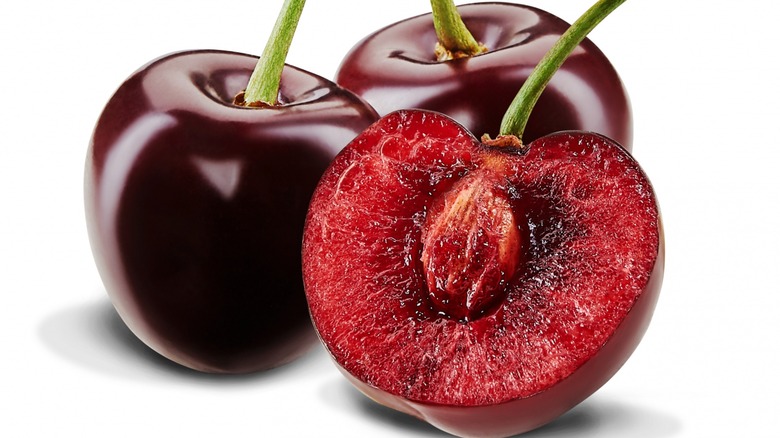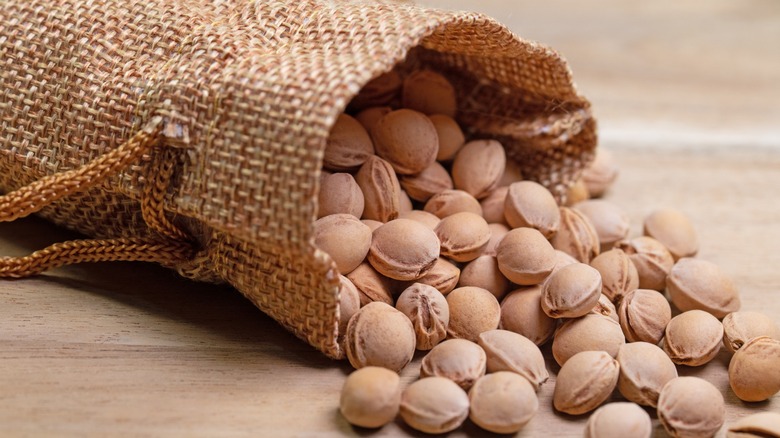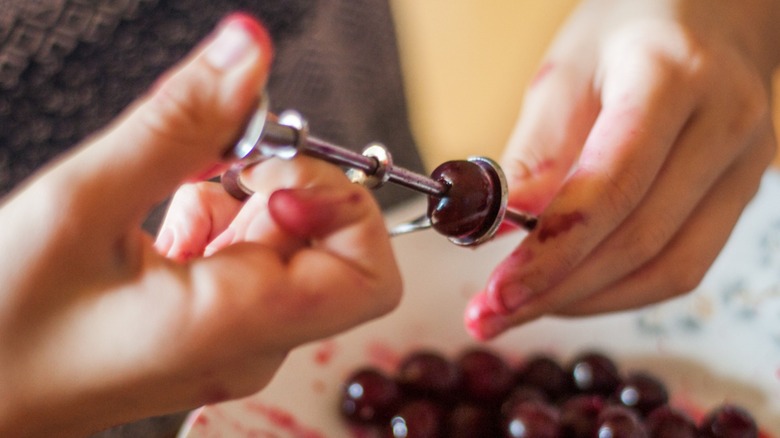Cherry Pits: Are They Safe To Eat?
When you were a little kid, you may have heard the old wives' tale to not swallow a cherry pit, or a cherry tree could grow in your belly. Like most warning tales, there was only a hint of truth to the story. You definitely shouldn't swallow cherry pits, not because a cherry tree will grow in your stomach, but because cherry pits can potentially become toxic.
According to Healthline, cherry pits contain amygdalin — a type of compound called cyanogenic glycoside — that, when crushed, can react with enzymes in our bodies to produce a small amount of toxic hydrogen cyanide. However, this deadly chemical is only released if the cherry pit is broken open. So, for example, if you chew on a cherry pit you could potentially put yourself at risk.
But this doesn't mean you have to stop eating fresh cherries forever. As the Missouri Poison Center notes, it's typically quite difficult to break open a hard cherry pit. Still, understanding what the risks are should you accidentally ingest one can offer you peace of mind and a game plan of what to do should you find yourself in this situation. Swallowing one, or even two, cherry pits is not a major cause for concern, according to Healthline, but, as with other potentially toxic substances, using the utmost caution is always the safest route.
Are cherry pits poisonous?
Cherry pits only become poisonous in the right context. Still, it's best to avoid swallowing them or having them in your mouth when possible. According to Healthline, if the cherry pit's naturally occurring amygdalin mixes with our bodies' enzymes — which typically only happens when the pit's hard outer shell is crushed or damaged — it reacts to become a small amount of the deadly poison hydrogen cyanide.
Different types of cherries produce different amounts of cyanide based on how much amygdalin is present in their pits. Black cherry pits contain 2.7 milligrams per gram, for example, while red cherry pits contain 3.9 milligrams per gram. Morello cherry pits, meanwhile, contain significantly more at 65 milligrams per gram. Depending on the amount of amygdalin present, cherry pits can release between 0.01 milligrams and 1.1 milligrams of cyanide. As Healthline notes, it takes around 0.2 to 1.6 milligrams of cyanide per pound of body weight to start experiencing signs of cyanide toxicity. Or, in more practical terms, around three to four crushed pits of a Morello cherry, or seven to nine pits of the red or black cherries.
The effects of cyanide will impact children more, and pits can also pose a choking hazard. If your child has ingested cherry pits, call Poison Control at 1-800-222-1222 or use the Poison Control Centers' web tool for further instruction. These numbers only apply to the situation of if you were to chew, bruise, or otherwise damage the exterior of a cherry pit and then swallow it. It takes considerable force to break a cherry pit, but the easiest way to avoid any potential poison is to de-pit your cherries before eating them or simply spit the pit out.
What to do if you swallow a cherry pit
As Healthline notes, ingesting one or two cherry pits typically isn't cause for concern. But, if you believe that three or more pits could have been swallowed, it's important to monitor symptoms and contact Poison Control for further help.
According to the Missouri Poison Center, symptoms of potential cyanide poisoning can include dizziness, headache, heightened anxiety, nausea, and throwing up. If you experience these symptoms call Poison Control at 1-800-222-1222 for medical guidance. But if you experience difficulty breathing, increased heart rate, kidney failure, or seizures, seek immediate medical help and call 911, as these are signs of serious cyanide poisoning.
Steps to follow if you or someone around you has swallowed a cherry pit:
-
Immediately rinse the mouth out with water and wipe the mouth out as well. Also, drink plenty of water.
-
Assess how many cherry pits were swallowed. If you believe that three or more cherry pits were ingested, call Poison Control at 1-800-222-1222 and seek medical attention.
-
Remain calm and monitor your body for symptoms. If you experience any of the symptoms mentioned above, seek medical attention or call 911 if symptoms are severe.
-
Continue to drink water and check in on yourself or others to assess your physical state.
-
Cherry pits typically pass through the body whole and are expelled in the stool. According to the Mayo Clinic, it takes around two to five days for stool to exit the body. Monitor bowel movements to ensure that the pit has passed.
-
Once your body has passed the pit(s), the risk of cyanide poisoning has passed as well.
How to easily remove cherry pits
The safest way to enjoy cherries is to remove their pits before eating them, especially when preparing to blend them, as pits are more likely to be damaged this way. You can opt to buy already pitted cherries or remove the cherry pits yourself, either manually or using a specially designed tool. Cherry pitter tools that easily and safely remove the pits of your cherries while preserving their delicate flesh can be found at most grocery stores or kitchen stores.
One of the easiest ways to pit a cherry is to use a plastic or metal straw and poke it through the center of the fruit, pushing the pit out. Wooden or metal kebab stakes are another easy at-home tool you can use to pit cherries. You can even use piping tips to poke cherry pits out. If you don't have anything long or thin enough, you can also use a sharp kitchen knife. Simply slice the cherry open and use your knife to remove the pit. Be sure to dispose of all pits carefully to prevent children, pets, or wild animals from accessing and swallowing them.



